Hospitality Operations: Food Production, Service Methods, Menu Planning, and Sustainability
VerifiedAdded on 2023/06/15
|10
|3246
|272
AI Summary
This report discusses the different types of food production systems, food and beverage service methods, menu planning considerations, and sustainable menu planning in the hospitality industry. The report focuses on the Savoy hotel in London, England. It covers topics such as call order, conventional, convenience, cook-chill, and assembly kitchen food production systems, as well as table service, English service, buffet service, cafeteria service, French service, and American service methods. The report also covers food preferences, style of food service, food habits, economic considerations, availability, variety in the menu, operational hours, skilled staff, language, occasions, and budget considerations for menu planning. Finally, the report discusses sustainable menu planning, including in-house production, planet-saving practices, on-site gardens, reducing food waste, buying in bulk, and garden programs.
Contribute Materials
Your contribution can guide someone’s learning journey. Share your
documents today.
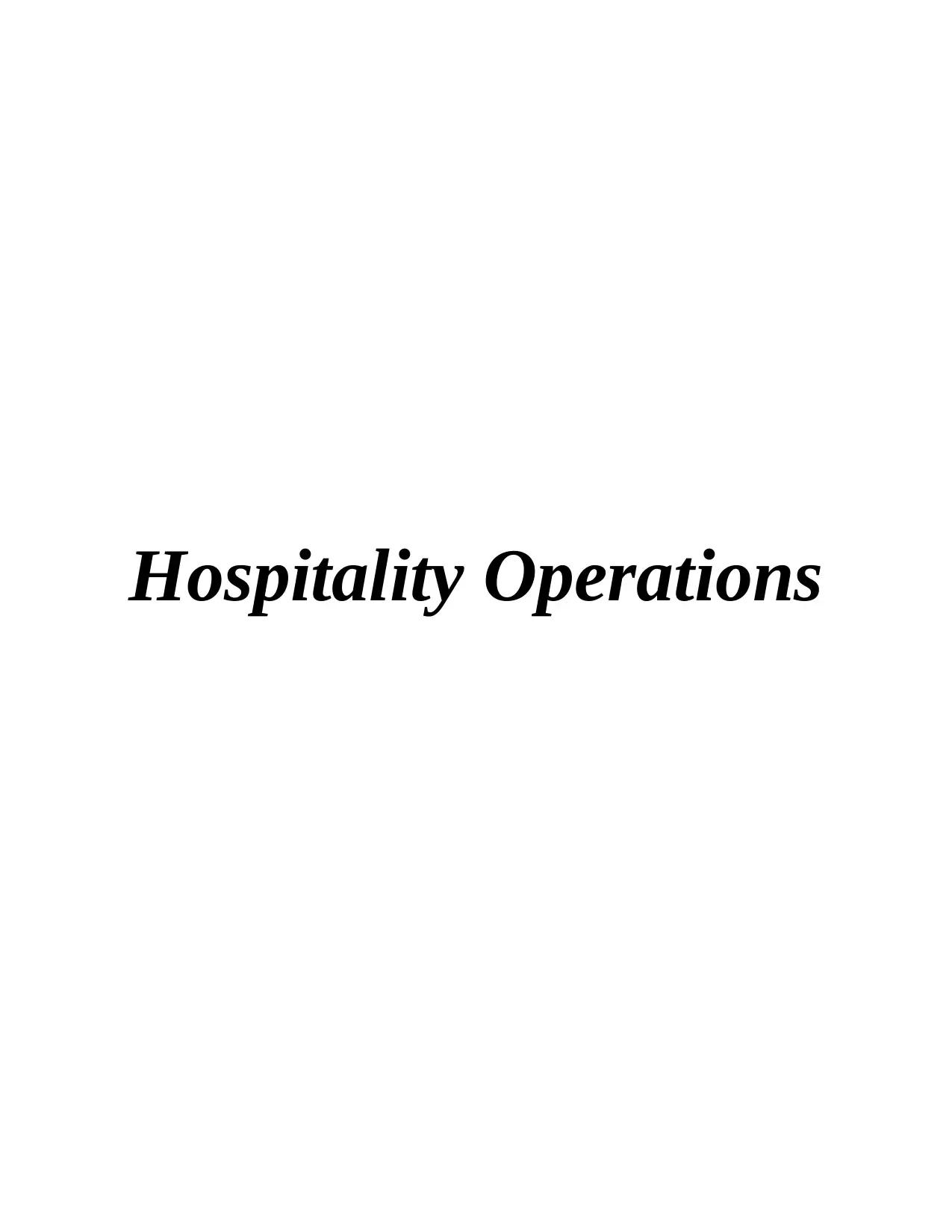
Hospitality Operations
Secure Best Marks with AI Grader
Need help grading? Try our AI Grader for instant feedback on your assignments.
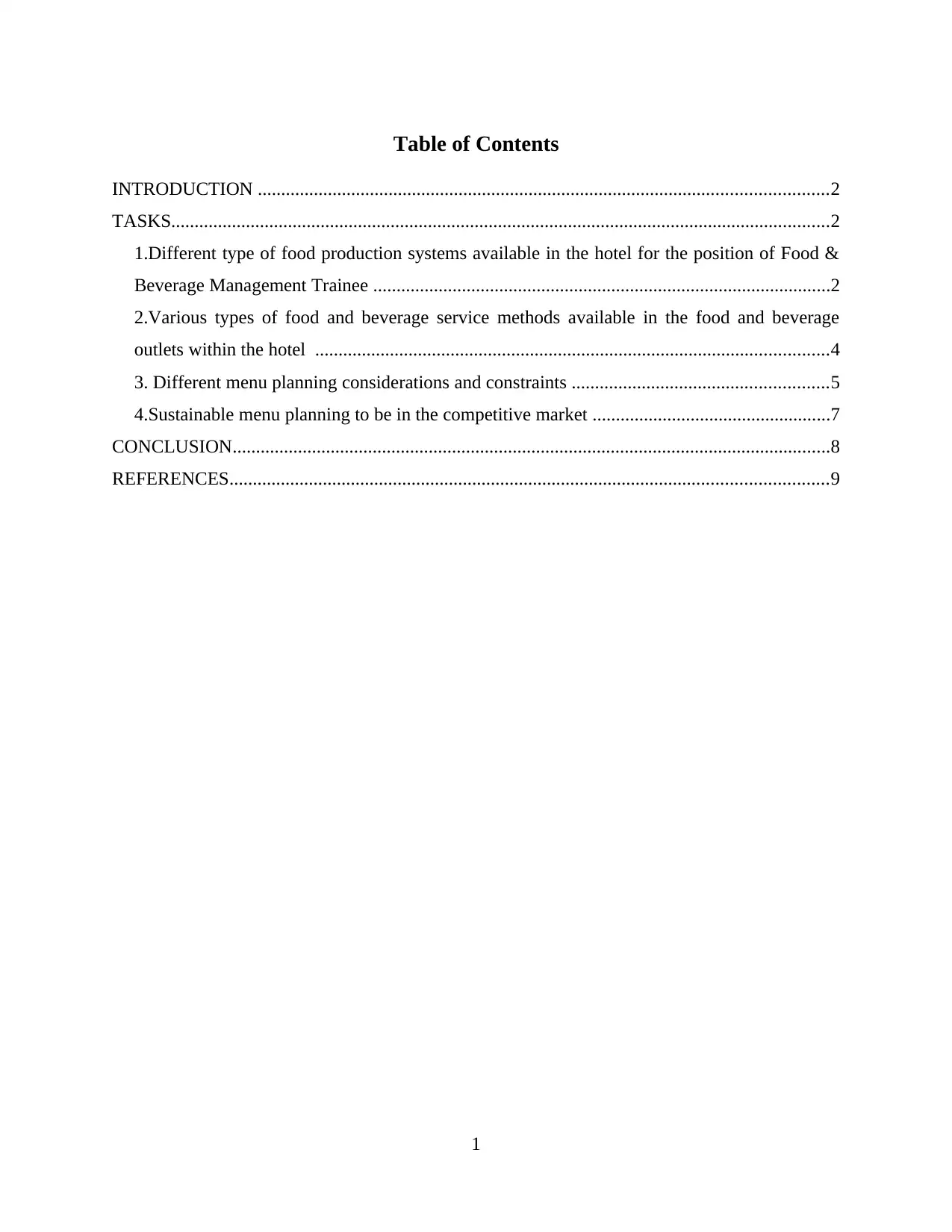
Table of Contents
INTRODUCTION ..........................................................................................................................2
TASKS.............................................................................................................................................2
1.Different type of food production systems available in the hotel for the position of Food &
Beverage Management Trainee ..................................................................................................2
2.Various types of food and beverage service methods available in the food and beverage
outlets within the hotel ..............................................................................................................4
3. Different menu planning considerations and constraints .......................................................5
4.Sustainable menu planning to be in the competitive market ...................................................7
CONCLUSION................................................................................................................................8
REFERENCES................................................................................................................................9
1
INTRODUCTION ..........................................................................................................................2
TASKS.............................................................................................................................................2
1.Different type of food production systems available in the hotel for the position of Food &
Beverage Management Trainee ..................................................................................................2
2.Various types of food and beverage service methods available in the food and beverage
outlets within the hotel ..............................................................................................................4
3. Different menu planning considerations and constraints .......................................................5
4.Sustainable menu planning to be in the competitive market ...................................................7
CONCLUSION................................................................................................................................8
REFERENCES................................................................................................................................9
1
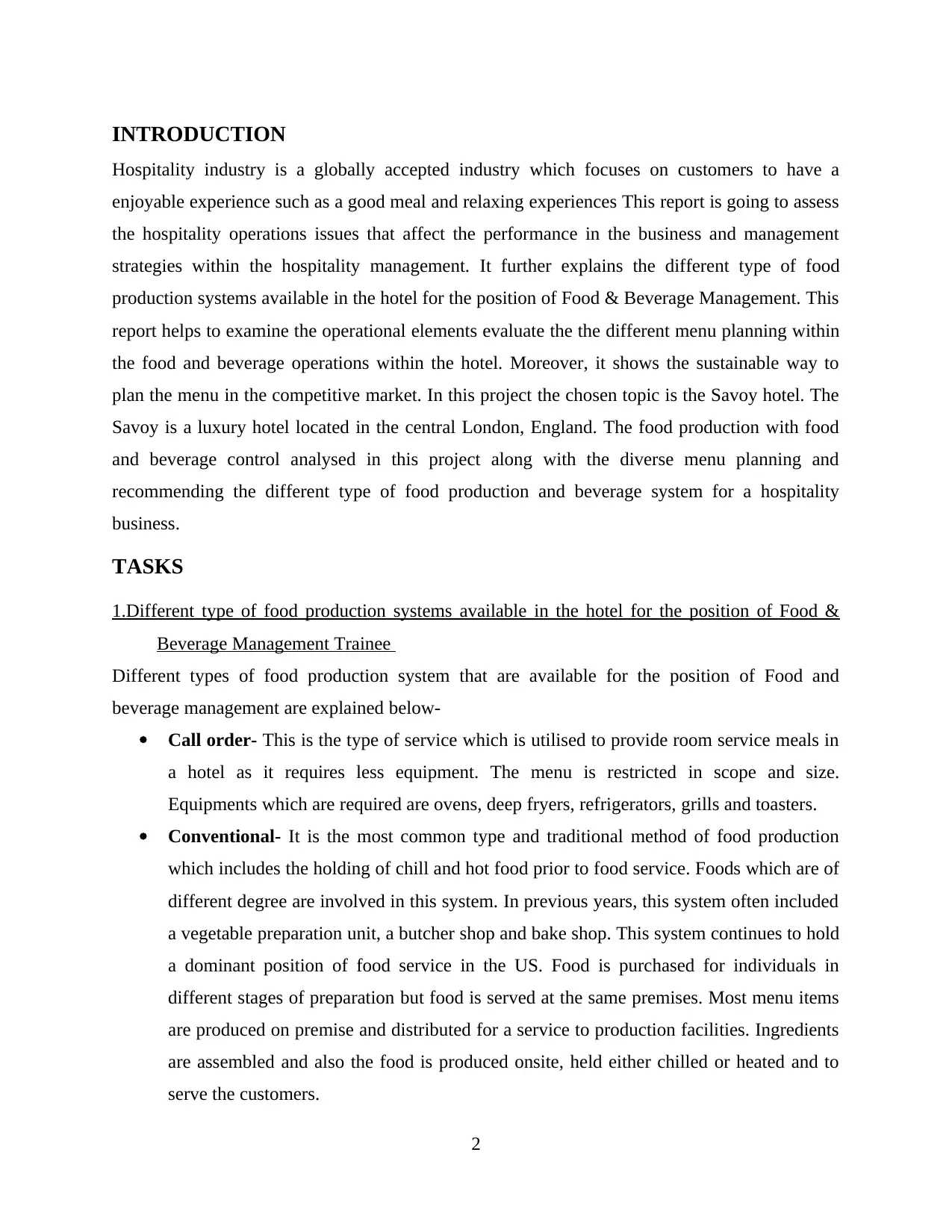
INTRODUCTION
Hospitality industry is a globally accepted industry which focuses on customers to have a
enjoyable experience such as a good meal and relaxing experiences This report is going to assess
the hospitality operations issues that affect the performance in the business and management
strategies within the hospitality management. It further explains the different type of food
production systems available in the hotel for the position of Food & Beverage Management. This
report helps to examine the operational elements evaluate the the different menu planning within
the food and beverage operations within the hotel. Moreover, it shows the sustainable way to
plan the menu in the competitive market. In this project the chosen topic is the Savoy hotel. The
Savoy is a luxury hotel located in the central London, England. The food production with food
and beverage control analysed in this project along with the diverse menu planning and
recommending the different type of food production and beverage system for a hospitality
business.
TASKS
1.Different type of food production systems available in the hotel for the position of Food &
Beverage Management Trainee
Different types of food production system that are available for the position of Food and
beverage management are explained below-
Call order- This is the type of service which is utilised to provide room service meals in
a hotel as it requires less equipment. The menu is restricted in scope and size.
Equipments which are required are ovens, deep fryers, refrigerators, grills and toasters.
Conventional- It is the most common type and traditional method of food production
which includes the holding of chill and hot food prior to food service. Foods which are of
different degree are involved in this system. In previous years, this system often included
a vegetable preparation unit, a butcher shop and bake shop. This system continues to hold
a dominant position of food service in the US. Food is purchased for individuals in
different stages of preparation but food is served at the same premises. Most menu items
are produced on premise and distributed for a service to production facilities. Ingredients
are assembled and also the food is produced onsite, held either chilled or heated and to
serve the customers.
2
Hospitality industry is a globally accepted industry which focuses on customers to have a
enjoyable experience such as a good meal and relaxing experiences This report is going to assess
the hospitality operations issues that affect the performance in the business and management
strategies within the hospitality management. It further explains the different type of food
production systems available in the hotel for the position of Food & Beverage Management. This
report helps to examine the operational elements evaluate the the different menu planning within
the food and beverage operations within the hotel. Moreover, it shows the sustainable way to
plan the menu in the competitive market. In this project the chosen topic is the Savoy hotel. The
Savoy is a luxury hotel located in the central London, England. The food production with food
and beverage control analysed in this project along with the diverse menu planning and
recommending the different type of food production and beverage system for a hospitality
business.
TASKS
1.Different type of food production systems available in the hotel for the position of Food &
Beverage Management Trainee
Different types of food production system that are available for the position of Food and
beverage management are explained below-
Call order- This is the type of service which is utilised to provide room service meals in
a hotel as it requires less equipment. The menu is restricted in scope and size.
Equipments which are required are ovens, deep fryers, refrigerators, grills and toasters.
Conventional- It is the most common type and traditional method of food production
which includes the holding of chill and hot food prior to food service. Foods which are of
different degree are involved in this system. In previous years, this system often included
a vegetable preparation unit, a butcher shop and bake shop. This system continues to hold
a dominant position of food service in the US. Food is purchased for individuals in
different stages of preparation but food is served at the same premises. Most menu items
are produced on premise and distributed for a service to production facilities. Ingredients
are assembled and also the food is produced onsite, held either chilled or heated and to
serve the customers.
2
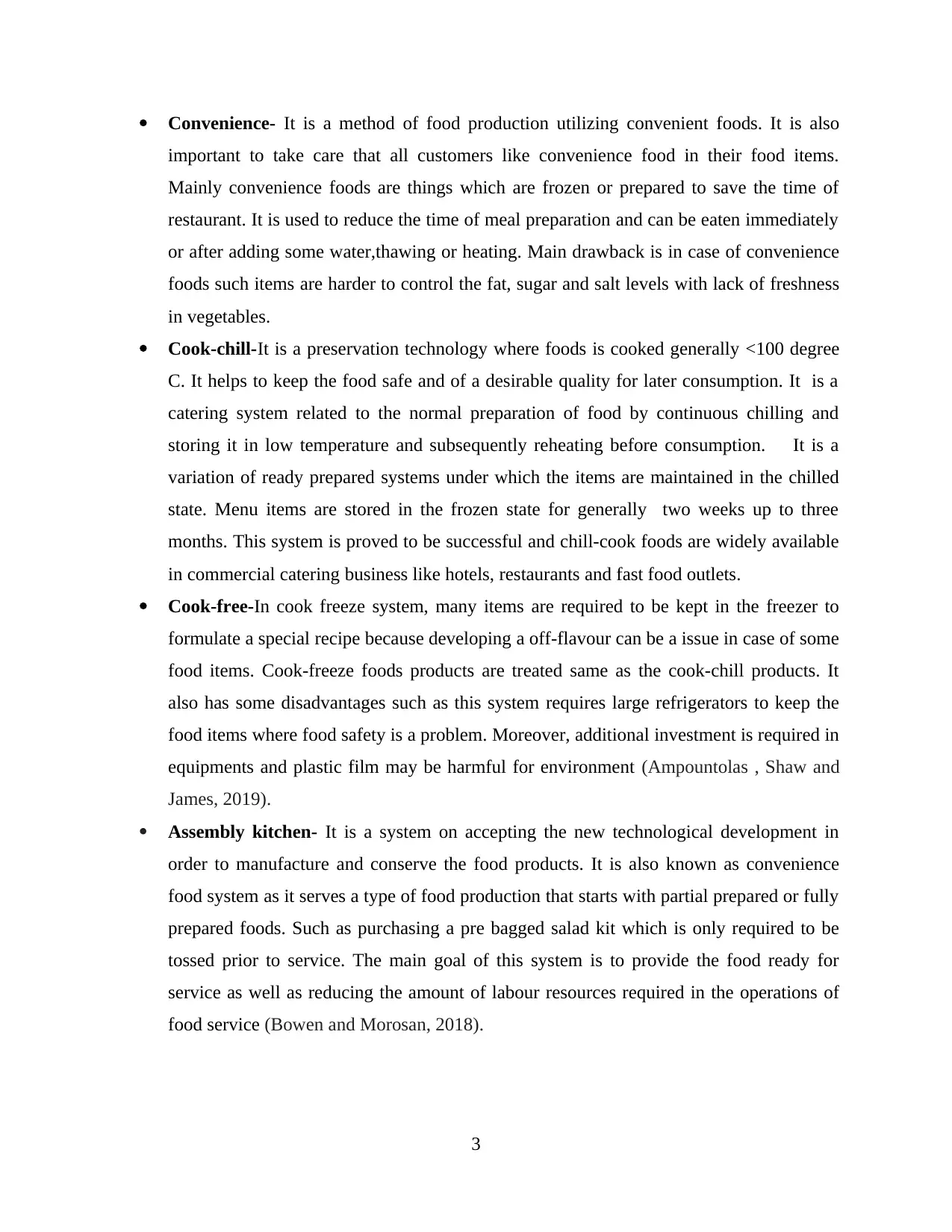
Convenience- It is a method of food production utilizing convenient foods. It is also
important to take care that all customers like convenience food in their food items.
Mainly convenience foods are things which are frozen or prepared to save the time of
restaurant. It is used to reduce the time of meal preparation and can be eaten immediately
or after adding some water,thawing or heating. Main drawback is in case of convenience
foods such items are harder to control the fat, sugar and salt levels with lack of freshness
in vegetables.
Cook-chill-It is a preservation technology where foods is cooked generally <100 degree
C. It helps to keep the food safe and of a desirable quality for later consumption. It is a
catering system related to the normal preparation of food by continuous chilling and
storing it in low temperature and subsequently reheating before consumption. It is a
variation of ready prepared systems under which the items are maintained in the chilled
state. Menu items are stored in the frozen state for generally two weeks up to three
months. This system is proved to be successful and chill-cook foods are widely available
in commercial catering business like hotels, restaurants and fast food outlets.
Cook-free-In cook freeze system, many items are required to be kept in the freezer to
formulate a special recipe because developing a off-flavour can be a issue in case of some
food items. Cook-freeze foods products are treated same as the cook-chill products. It
also has some disadvantages such as this system requires large refrigerators to keep the
food items where food safety is a problem. Moreover, additional investment is required in
equipments and plastic film may be harmful for environment (Ampountolas , Shaw and
James, 2019).
Assembly kitchen- It is a system on accepting the new technological development in
order to manufacture and conserve the food products. It is also known as convenience
food system as it serves a type of food production that starts with partial prepared or fully
prepared foods. Such as purchasing a pre bagged salad kit which is only required to be
tossed prior to service. The main goal of this system is to provide the food ready for
service as well as reducing the amount of labour resources required in the operations of
food service (Bowen and Morosan, 2018).
3
important to take care that all customers like convenience food in their food items.
Mainly convenience foods are things which are frozen or prepared to save the time of
restaurant. It is used to reduce the time of meal preparation and can be eaten immediately
or after adding some water,thawing or heating. Main drawback is in case of convenience
foods such items are harder to control the fat, sugar and salt levels with lack of freshness
in vegetables.
Cook-chill-It is a preservation technology where foods is cooked generally <100 degree
C. It helps to keep the food safe and of a desirable quality for later consumption. It is a
catering system related to the normal preparation of food by continuous chilling and
storing it in low temperature and subsequently reheating before consumption. It is a
variation of ready prepared systems under which the items are maintained in the chilled
state. Menu items are stored in the frozen state for generally two weeks up to three
months. This system is proved to be successful and chill-cook foods are widely available
in commercial catering business like hotels, restaurants and fast food outlets.
Cook-free-In cook freeze system, many items are required to be kept in the freezer to
formulate a special recipe because developing a off-flavour can be a issue in case of some
food items. Cook-freeze foods products are treated same as the cook-chill products. It
also has some disadvantages such as this system requires large refrigerators to keep the
food items where food safety is a problem. Moreover, additional investment is required in
equipments and plastic film may be harmful for environment (Ampountolas , Shaw and
James, 2019).
Assembly kitchen- It is a system on accepting the new technological development in
order to manufacture and conserve the food products. It is also known as convenience
food system as it serves a type of food production that starts with partial prepared or fully
prepared foods. Such as purchasing a pre bagged salad kit which is only required to be
tossed prior to service. The main goal of this system is to provide the food ready for
service as well as reducing the amount of labour resources required in the operations of
food service (Bowen and Morosan, 2018).
3
Secure Best Marks with AI Grader
Need help grading? Try our AI Grader for instant feedback on your assignments.
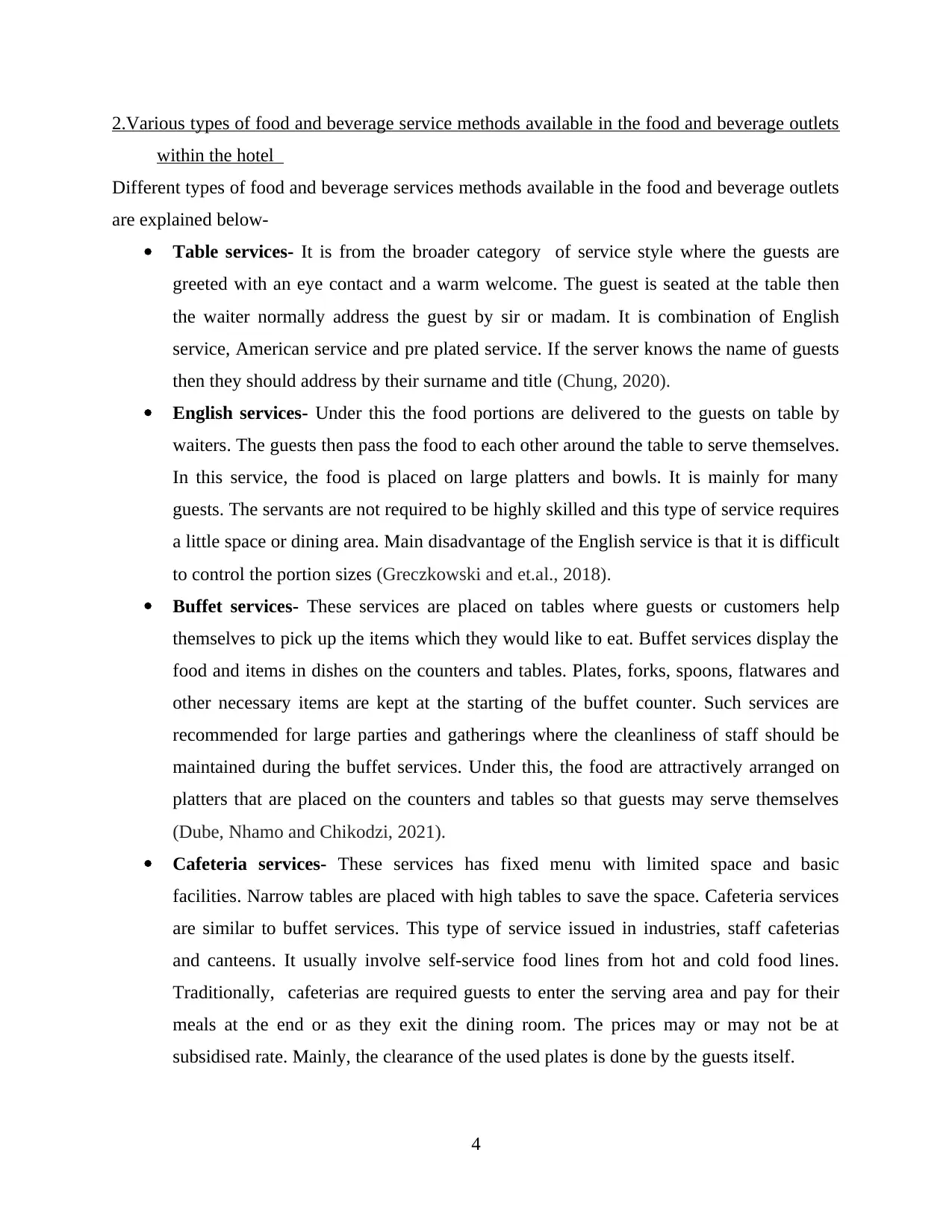
2.Various types of food and beverage service methods available in the food and beverage outlets
within the hotel
Different types of food and beverage services methods available in the food and beverage outlets
are explained below-
Table services- It is from the broader category of service style where the guests are
greeted with an eye contact and a warm welcome. The guest is seated at the table then
the waiter normally address the guest by sir or madam. It is combination of English
service, American service and pre plated service. If the server knows the name of guests
then they should address by their surname and title (Chung, 2020).
English services- Under this the food portions are delivered to the guests on table by
waiters. The guests then pass the food to each other around the table to serve themselves.
In this service, the food is placed on large platters and bowls. It is mainly for many
guests. The servants are not required to be highly skilled and this type of service requires
a little space or dining area. Main disadvantage of the English service is that it is difficult
to control the portion sizes (Greczkowski and et.al., 2018).
Buffet services- These services are placed on tables where guests or customers help
themselves to pick up the items which they would like to eat. Buffet services display the
food and items in dishes on the counters and tables. Plates, forks, spoons, flatwares and
other necessary items are kept at the starting of the buffet counter. Such services are
recommended for large parties and gatherings where the cleanliness of staff should be
maintained during the buffet services. Under this, the food are attractively arranged on
platters that are placed on the counters and tables so that guests may serve themselves
(Dube, Nhamo and Chikodzi, 2021).
Cafeteria services- These services has fixed menu with limited space and basic
facilities. Narrow tables are placed with high tables to save the space. Cafeteria services
are similar to buffet services. This type of service issued in industries, staff cafeterias
and canteens. It usually involve self-service food lines from hot and cold food lines.
Traditionally, cafeterias are required guests to enter the serving area and pay for their
meals at the end or as they exit the dining room. The prices may or may not be at
subsidised rate. Mainly, the clearance of the used plates is done by the guests itself.
4
within the hotel
Different types of food and beverage services methods available in the food and beverage outlets
are explained below-
Table services- It is from the broader category of service style where the guests are
greeted with an eye contact and a warm welcome. The guest is seated at the table then
the waiter normally address the guest by sir or madam. It is combination of English
service, American service and pre plated service. If the server knows the name of guests
then they should address by their surname and title (Chung, 2020).
English services- Under this the food portions are delivered to the guests on table by
waiters. The guests then pass the food to each other around the table to serve themselves.
In this service, the food is placed on large platters and bowls. It is mainly for many
guests. The servants are not required to be highly skilled and this type of service requires
a little space or dining area. Main disadvantage of the English service is that it is difficult
to control the portion sizes (Greczkowski and et.al., 2018).
Buffet services- These services are placed on tables where guests or customers help
themselves to pick up the items which they would like to eat. Buffet services display the
food and items in dishes on the counters and tables. Plates, forks, spoons, flatwares and
other necessary items are kept at the starting of the buffet counter. Such services are
recommended for large parties and gatherings where the cleanliness of staff should be
maintained during the buffet services. Under this, the food are attractively arranged on
platters that are placed on the counters and tables so that guests may serve themselves
(Dube, Nhamo and Chikodzi, 2021).
Cafeteria services- These services has fixed menu with limited space and basic
facilities. Narrow tables are placed with high tables to save the space. Cafeteria services
are similar to buffet services. This type of service issued in industries, staff cafeterias
and canteens. It usually involve self-service food lines from hot and cold food lines.
Traditionally, cafeterias are required guests to enter the serving area and pay for their
meals at the end or as they exit the dining room. The prices may or may not be at
subsidised rate. Mainly, the clearance of the used plates is done by the guests itself.
4
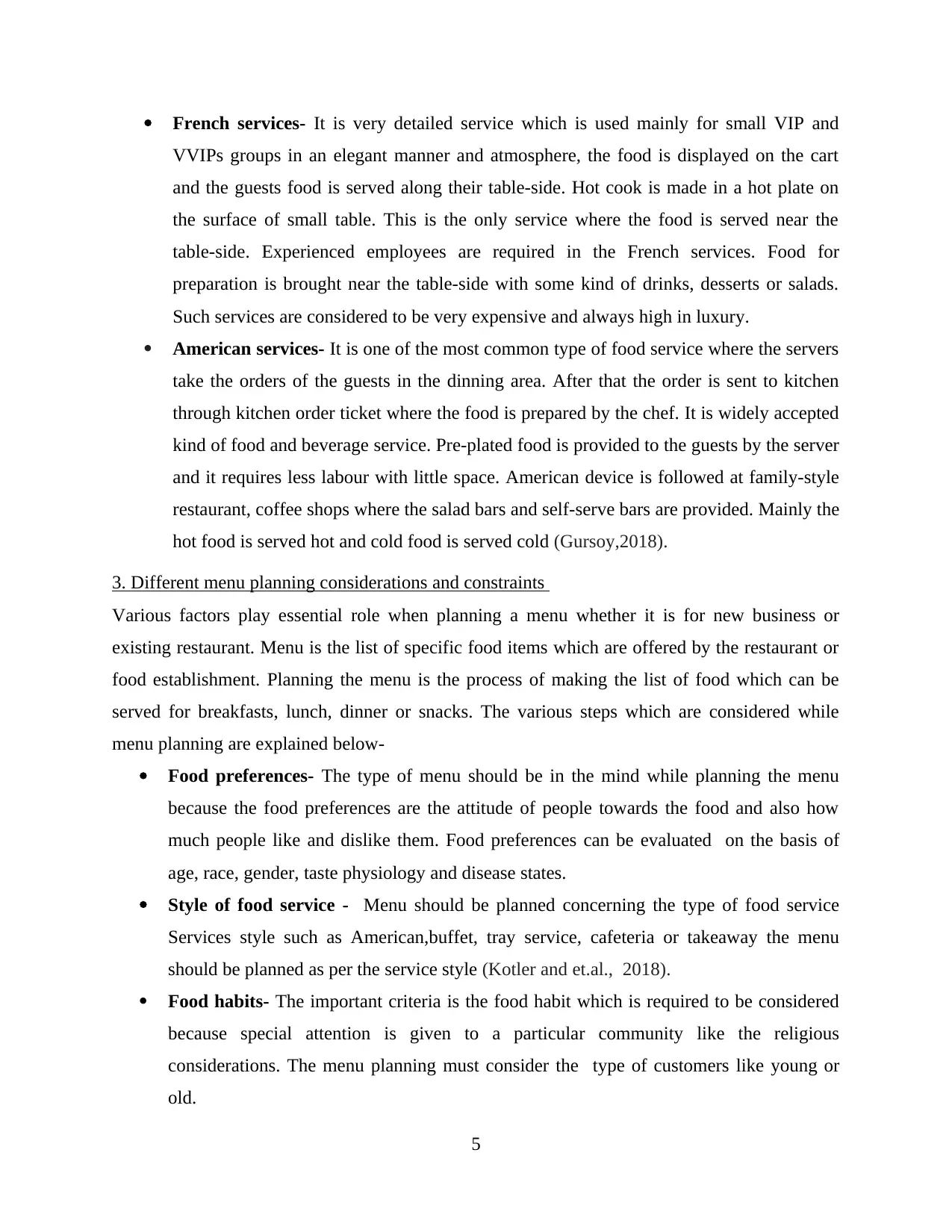
French services- It is very detailed service which is used mainly for small VIP and
VVIPs groups in an elegant manner and atmosphere, the food is displayed on the cart
and the guests food is served along their table-side. Hot cook is made in a hot plate on
the surface of small table. This is the only service where the food is served near the
table-side. Experienced employees are required in the French services. Food for
preparation is brought near the table-side with some kind of drinks, desserts or salads.
Such services are considered to be very expensive and always high in luxury.
American services- It is one of the most common type of food service where the servers
take the orders of the guests in the dinning area. After that the order is sent to kitchen
through kitchen order ticket where the food is prepared by the chef. It is widely accepted
kind of food and beverage service. Pre-plated food is provided to the guests by the server
and it requires less labour with little space. American device is followed at family-style
restaurant, coffee shops where the salad bars and self-serve bars are provided. Mainly the
hot food is served hot and cold food is served cold (Gursoy,2018).
3. Different menu planning considerations and constraints
Various factors play essential role when planning a menu whether it is for new business or
existing restaurant. Menu is the list of specific food items which are offered by the restaurant or
food establishment. Planning the menu is the process of making the list of food which can be
served for breakfasts, lunch, dinner or snacks. The various steps which are considered while
menu planning are explained below-
Food preferences- The type of menu should be in the mind while planning the menu
because the food preferences are the attitude of people towards the food and also how
much people like and dislike them. Food preferences can be evaluated on the basis of
age, race, gender, taste physiology and disease states.
Style of food service - Menu should be planned concerning the type of food service
Services style such as American,buffet, tray service, cafeteria or takeaway the menu
should be planned as per the service style (Kotler and et.al., 2018).
Food habits- The important criteria is the food habit which is required to be considered
because special attention is given to a particular community like the religious
considerations. The menu planning must consider the type of customers like young or
old.
5
VVIPs groups in an elegant manner and atmosphere, the food is displayed on the cart
and the guests food is served along their table-side. Hot cook is made in a hot plate on
the surface of small table. This is the only service where the food is served near the
table-side. Experienced employees are required in the French services. Food for
preparation is brought near the table-side with some kind of drinks, desserts or salads.
Such services are considered to be very expensive and always high in luxury.
American services- It is one of the most common type of food service where the servers
take the orders of the guests in the dinning area. After that the order is sent to kitchen
through kitchen order ticket where the food is prepared by the chef. It is widely accepted
kind of food and beverage service. Pre-plated food is provided to the guests by the server
and it requires less labour with little space. American device is followed at family-style
restaurant, coffee shops where the salad bars and self-serve bars are provided. Mainly the
hot food is served hot and cold food is served cold (Gursoy,2018).
3. Different menu planning considerations and constraints
Various factors play essential role when planning a menu whether it is for new business or
existing restaurant. Menu is the list of specific food items which are offered by the restaurant or
food establishment. Planning the menu is the process of making the list of food which can be
served for breakfasts, lunch, dinner or snacks. The various steps which are considered while
menu planning are explained below-
Food preferences- The type of menu should be in the mind while planning the menu
because the food preferences are the attitude of people towards the food and also how
much people like and dislike them. Food preferences can be evaluated on the basis of
age, race, gender, taste physiology and disease states.
Style of food service - Menu should be planned concerning the type of food service
Services style such as American,buffet, tray service, cafeteria or takeaway the menu
should be planned as per the service style (Kotler and et.al., 2018).
Food habits- The important criteria is the food habit which is required to be considered
because special attention is given to a particular community like the religious
considerations. The menu planning must consider the type of customers like young or
old.
5
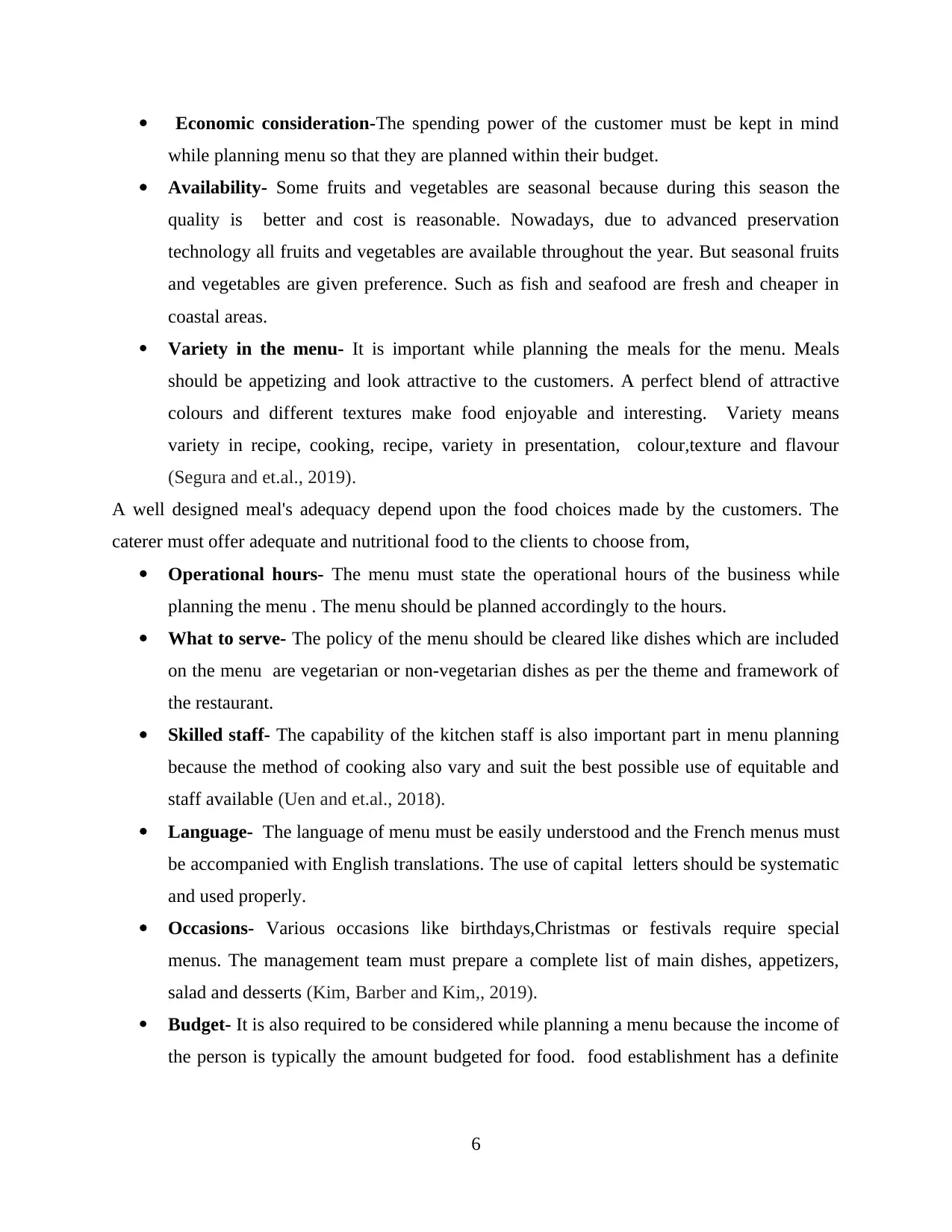
Economic consideration-The spending power of the customer must be kept in mind
while planning menu so that they are planned within their budget.
Availability- Some fruits and vegetables are seasonal because during this season the
quality is better and cost is reasonable. Nowadays, due to advanced preservation
technology all fruits and vegetables are available throughout the year. But seasonal fruits
and vegetables are given preference. Such as fish and seafood are fresh and cheaper in
coastal areas.
Variety in the menu- It is important while planning the meals for the menu. Meals
should be appetizing and look attractive to the customers. A perfect blend of attractive
colours and different textures make food enjoyable and interesting. Variety means
variety in recipe, cooking, recipe, variety in presentation, colour,texture and flavour
(Segura and et.al., 2019).
A well designed meal's adequacy depend upon the food choices made by the customers. The
caterer must offer adequate and nutritional food to the clients to choose from,
Operational hours- The menu must state the operational hours of the business while
planning the menu . The menu should be planned accordingly to the hours.
What to serve- The policy of the menu should be cleared like dishes which are included
on the menu are vegetarian or non-vegetarian dishes as per the theme and framework of
the restaurant.
Skilled staff- The capability of the kitchen staff is also important part in menu planning
because the method of cooking also vary and suit the best possible use of equitable and
staff available (Uen and et.al., 2018).
Language- The language of menu must be easily understood and the French menus must
be accompanied with English translations. The use of capital letters should be systematic
and used properly.
Occasions- Various occasions like birthdays,Christmas or festivals require special
menus. The management team must prepare a complete list of main dishes, appetizers,
salad and desserts (Kim, Barber and Kim,, 2019).
Budget- It is also required to be considered while planning a menu because the income of
the person is typically the amount budgeted for food. food establishment has a definite
6
while planning menu so that they are planned within their budget.
Availability- Some fruits and vegetables are seasonal because during this season the
quality is better and cost is reasonable. Nowadays, due to advanced preservation
technology all fruits and vegetables are available throughout the year. But seasonal fruits
and vegetables are given preference. Such as fish and seafood are fresh and cheaper in
coastal areas.
Variety in the menu- It is important while planning the meals for the menu. Meals
should be appetizing and look attractive to the customers. A perfect blend of attractive
colours and different textures make food enjoyable and interesting. Variety means
variety in recipe, cooking, recipe, variety in presentation, colour,texture and flavour
(Segura and et.al., 2019).
A well designed meal's adequacy depend upon the food choices made by the customers. The
caterer must offer adequate and nutritional food to the clients to choose from,
Operational hours- The menu must state the operational hours of the business while
planning the menu . The menu should be planned accordingly to the hours.
What to serve- The policy of the menu should be cleared like dishes which are included
on the menu are vegetarian or non-vegetarian dishes as per the theme and framework of
the restaurant.
Skilled staff- The capability of the kitchen staff is also important part in menu planning
because the method of cooking also vary and suit the best possible use of equitable and
staff available (Uen and et.al., 2018).
Language- The language of menu must be easily understood and the French menus must
be accompanied with English translations. The use of capital letters should be systematic
and used properly.
Occasions- Various occasions like birthdays,Christmas or festivals require special
menus. The management team must prepare a complete list of main dishes, appetizers,
salad and desserts (Kim, Barber and Kim,, 2019).
Budget- It is also required to be considered while planning a menu because the income of
the person is typically the amount budgeted for food. food establishment has a definite
6
Paraphrase This Document
Need a fresh take? Get an instant paraphrase of this document with our AI Paraphraser
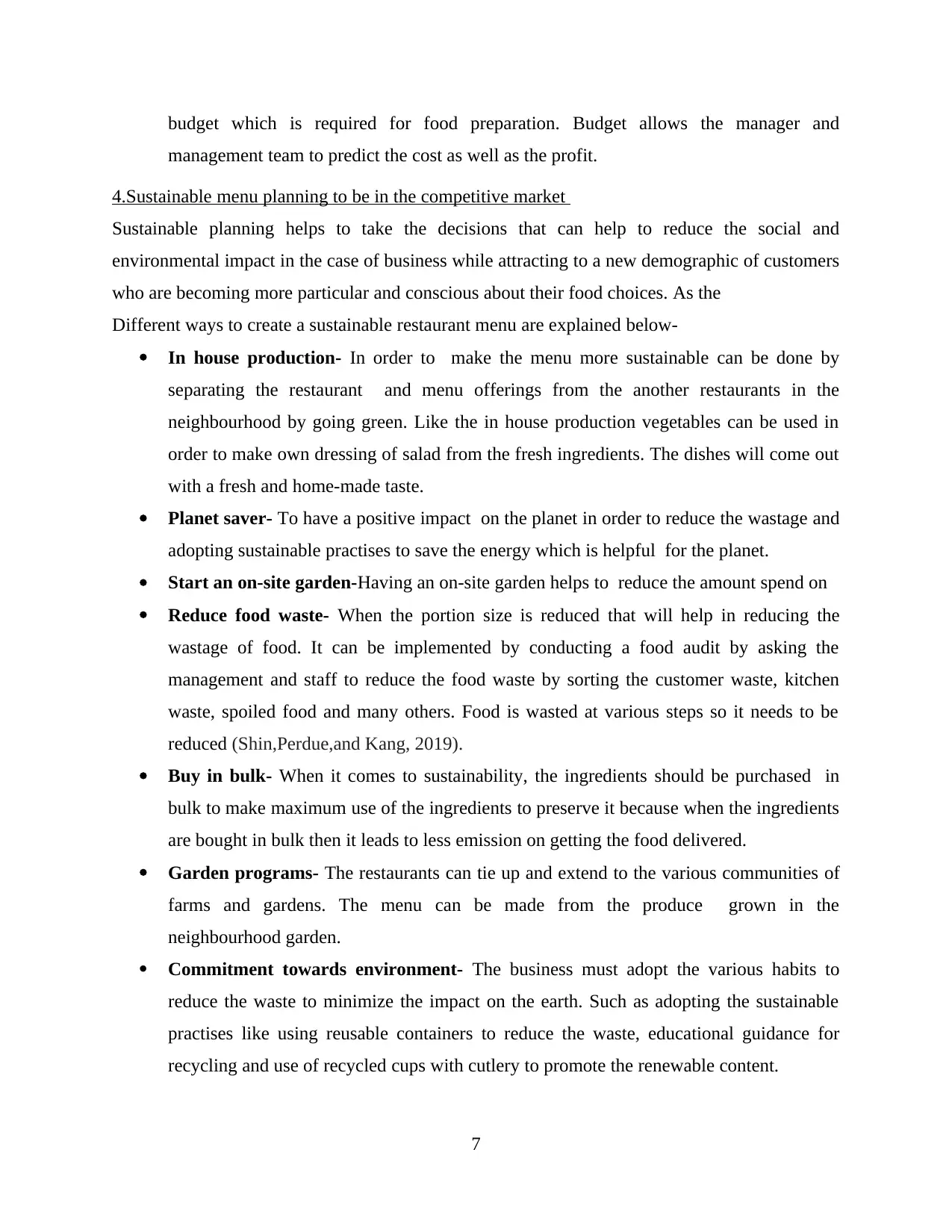
budget which is required for food preparation. Budget allows the manager and
management team to predict the cost as well as the profit.
4.Sustainable menu planning to be in the competitive market
Sustainable planning helps to take the decisions that can help to reduce the social and
environmental impact in the case of business while attracting to a new demographic of customers
who are becoming more particular and conscious about their food choices. As the
Different ways to create a sustainable restaurant menu are explained below-
In house production- In order to make the menu more sustainable can be done by
separating the restaurant and menu offerings from the another restaurants in the
neighbourhood by going green. Like the in house production vegetables can be used in
order to make own dressing of salad from the fresh ingredients. The dishes will come out
with a fresh and home-made taste.
Planet saver- To have a positive impact on the planet in order to reduce the wastage and
adopting sustainable practises to save the energy which is helpful for the planet.
Start an on-site garden-Having an on-site garden helps to reduce the amount spend on
Reduce food waste- When the portion size is reduced that will help in reducing the
wastage of food. It can be implemented by conducting a food audit by asking the
management and staff to reduce the food waste by sorting the customer waste, kitchen
waste, spoiled food and many others. Food is wasted at various steps so it needs to be
reduced (Shin,Perdue,and Kang, 2019).
Buy in bulk- When it comes to sustainability, the ingredients should be purchased in
bulk to make maximum use of the ingredients to preserve it because when the ingredients
are bought in bulk then it leads to less emission on getting the food delivered.
Garden programs- The restaurants can tie up and extend to the various communities of
farms and gardens. The menu can be made from the produce grown in the
neighbourhood garden.
Commitment towards environment- The business must adopt the various habits to
reduce the waste to minimize the impact on the earth. Such as adopting the sustainable
practises like using reusable containers to reduce the waste, educational guidance for
recycling and use of recycled cups with cutlery to promote the renewable content.
7
management team to predict the cost as well as the profit.
4.Sustainable menu planning to be in the competitive market
Sustainable planning helps to take the decisions that can help to reduce the social and
environmental impact in the case of business while attracting to a new demographic of customers
who are becoming more particular and conscious about their food choices. As the
Different ways to create a sustainable restaurant menu are explained below-
In house production- In order to make the menu more sustainable can be done by
separating the restaurant and menu offerings from the another restaurants in the
neighbourhood by going green. Like the in house production vegetables can be used in
order to make own dressing of salad from the fresh ingredients. The dishes will come out
with a fresh and home-made taste.
Planet saver- To have a positive impact on the planet in order to reduce the wastage and
adopting sustainable practises to save the energy which is helpful for the planet.
Start an on-site garden-Having an on-site garden helps to reduce the amount spend on
Reduce food waste- When the portion size is reduced that will help in reducing the
wastage of food. It can be implemented by conducting a food audit by asking the
management and staff to reduce the food waste by sorting the customer waste, kitchen
waste, spoiled food and many others. Food is wasted at various steps so it needs to be
reduced (Shin,Perdue,and Kang, 2019).
Buy in bulk- When it comes to sustainability, the ingredients should be purchased in
bulk to make maximum use of the ingredients to preserve it because when the ingredients
are bought in bulk then it leads to less emission on getting the food delivered.
Garden programs- The restaurants can tie up and extend to the various communities of
farms and gardens. The menu can be made from the produce grown in the
neighbourhood garden.
Commitment towards environment- The business must adopt the various habits to
reduce the waste to minimize the impact on the earth. Such as adopting the sustainable
practises like using reusable containers to reduce the waste, educational guidance for
recycling and use of recycled cups with cutlery to promote the renewable content.
7
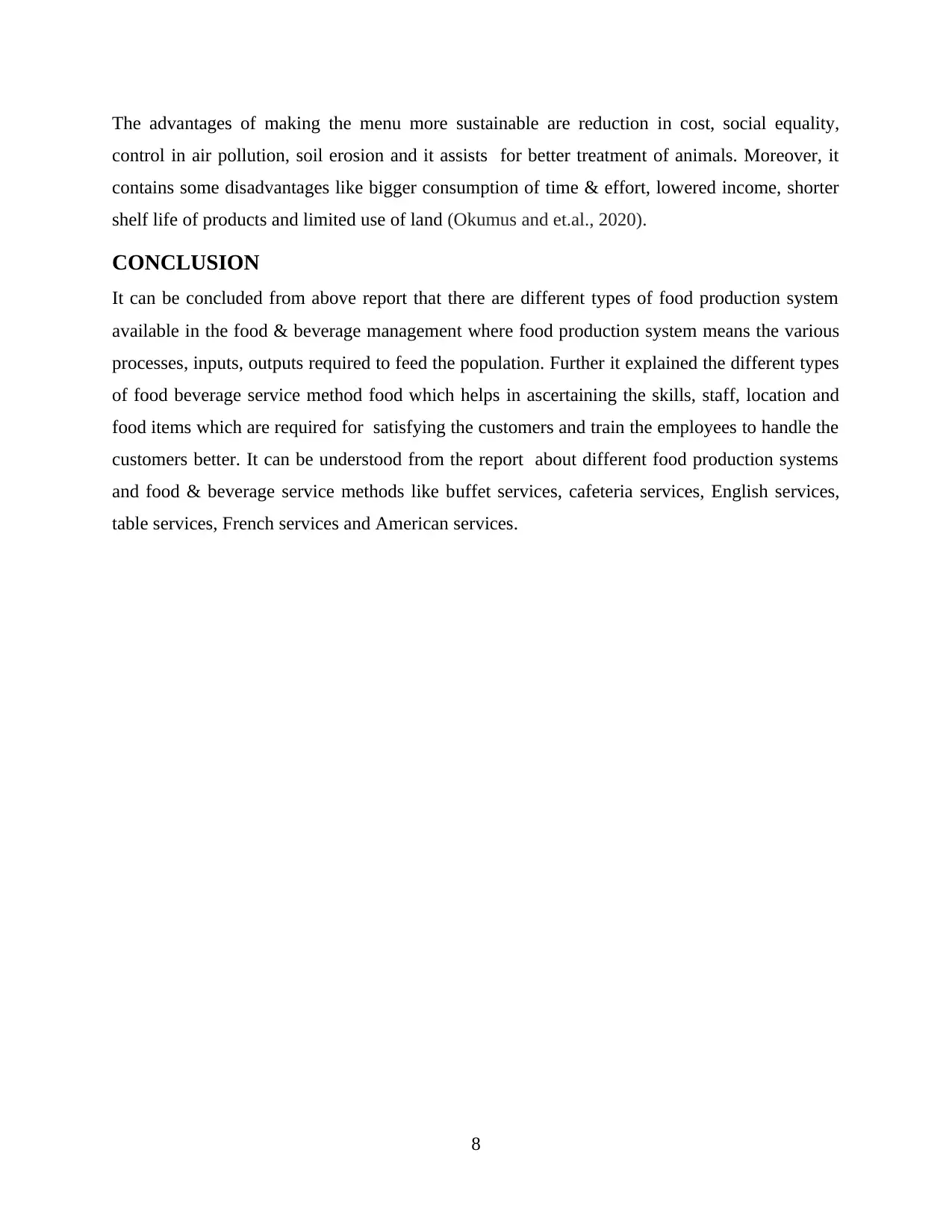
The advantages of making the menu more sustainable are reduction in cost, social equality,
control in air pollution, soil erosion and it assists for better treatment of animals. Moreover, it
contains some disadvantages like bigger consumption of time & effort, lowered income, shorter
shelf life of products and limited use of land (Okumus and et.al., 2020).
CONCLUSION
It can be concluded from above report that there are different types of food production system
available in the food & beverage management where food production system means the various
processes, inputs, outputs required to feed the population. Further it explained the different types
of food beverage service method food which helps in ascertaining the skills, staff, location and
food items which are required for satisfying the customers and train the employees to handle the
customers better. It can be understood from the report about different food production systems
and food & beverage service methods like buffet services, cafeteria services, English services,
table services, French services and American services.
8
control in air pollution, soil erosion and it assists for better treatment of animals. Moreover, it
contains some disadvantages like bigger consumption of time & effort, lowered income, shorter
shelf life of products and limited use of land (Okumus and et.al., 2020).
CONCLUSION
It can be concluded from above report that there are different types of food production system
available in the food & beverage management where food production system means the various
processes, inputs, outputs required to feed the population. Further it explained the different types
of food beverage service method food which helps in ascertaining the skills, staff, location and
food items which are required for satisfying the customers and train the employees to handle the
customers better. It can be understood from the report about different food production systems
and food & beverage service methods like buffet services, cafeteria services, English services,
table services, French services and American services.
8
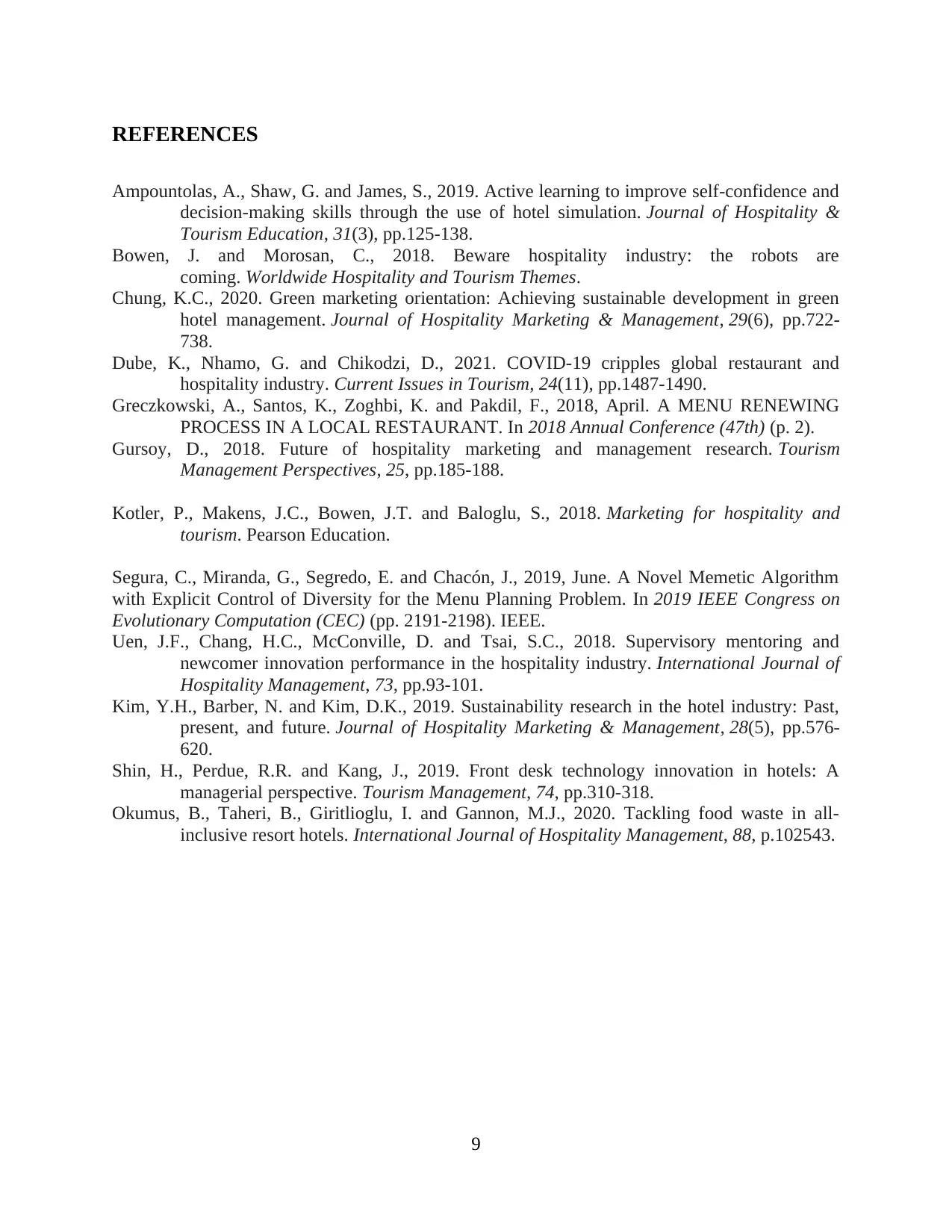
REFERENCES
Ampountolas, A., Shaw, G. and James, S., 2019. Active learning to improve self-confidence and
decision-making skills through the use of hotel simulation. Journal of Hospitality &
Tourism Education, 31(3), pp.125-138.
Bowen, J. and Morosan, C., 2018. Beware hospitality industry: the robots are
coming. Worldwide Hospitality and Tourism Themes.
Chung, K.C., 2020. Green marketing orientation: Achieving sustainable development in green
hotel management. Journal of Hospitality Marketing & Management, 29(6), pp.722-
738.
Dube, K., Nhamo, G. and Chikodzi, D., 2021. COVID-19 cripples global restaurant and
hospitality industry. Current Issues in Tourism, 24(11), pp.1487-1490.
Greczkowski, A., Santos, K., Zoghbi, K. and Pakdil, F., 2018, April. A MENU RENEWING
PROCESS IN A LOCAL RESTAURANT. In 2018 Annual Conference (47th) (p. 2).
Gursoy, D., 2018. Future of hospitality marketing and management research. Tourism
Management Perspectives, 25, pp.185-188.
Kotler, P., Makens, J.C., Bowen, J.T. and Baloglu, S., 2018. Marketing for hospitality and
tourism. Pearson Education.
Segura, C., Miranda, G., Segredo, E. and Chacón, J., 2019, June. A Novel Memetic Algorithm
with Explicit Control of Diversity for the Menu Planning Problem. In 2019 IEEE Congress on
Evolutionary Computation (CEC) (pp. 2191-2198). IEEE.
Uen, J.F., Chang, H.C., McConville, D. and Tsai, S.C., 2018. Supervisory mentoring and
newcomer innovation performance in the hospitality industry. International Journal of
Hospitality Management, 73, pp.93-101.
Kim, Y.H., Barber, N. and Kim, D.K., 2019. Sustainability research in the hotel industry: Past,
present, and future. Journal of Hospitality Marketing & Management, 28(5), pp.576-
620.
Shin, H., Perdue, R.R. and Kang, J., 2019. Front desk technology innovation in hotels: A
managerial perspective. Tourism Management, 74, pp.310-318.
Okumus, B., Taheri, B., Giritlioglu, I. and Gannon, M.J., 2020. Tackling food waste in all-
inclusive resort hotels. International Journal of Hospitality Management, 88, p.102543.
9
Ampountolas, A., Shaw, G. and James, S., 2019. Active learning to improve self-confidence and
decision-making skills through the use of hotel simulation. Journal of Hospitality &
Tourism Education, 31(3), pp.125-138.
Bowen, J. and Morosan, C., 2018. Beware hospitality industry: the robots are
coming. Worldwide Hospitality and Tourism Themes.
Chung, K.C., 2020. Green marketing orientation: Achieving sustainable development in green
hotel management. Journal of Hospitality Marketing & Management, 29(6), pp.722-
738.
Dube, K., Nhamo, G. and Chikodzi, D., 2021. COVID-19 cripples global restaurant and
hospitality industry. Current Issues in Tourism, 24(11), pp.1487-1490.
Greczkowski, A., Santos, K., Zoghbi, K. and Pakdil, F., 2018, April. A MENU RENEWING
PROCESS IN A LOCAL RESTAURANT. In 2018 Annual Conference (47th) (p. 2).
Gursoy, D., 2018. Future of hospitality marketing and management research. Tourism
Management Perspectives, 25, pp.185-188.
Kotler, P., Makens, J.C., Bowen, J.T. and Baloglu, S., 2018. Marketing for hospitality and
tourism. Pearson Education.
Segura, C., Miranda, G., Segredo, E. and Chacón, J., 2019, June. A Novel Memetic Algorithm
with Explicit Control of Diversity for the Menu Planning Problem. In 2019 IEEE Congress on
Evolutionary Computation (CEC) (pp. 2191-2198). IEEE.
Uen, J.F., Chang, H.C., McConville, D. and Tsai, S.C., 2018. Supervisory mentoring and
newcomer innovation performance in the hospitality industry. International Journal of
Hospitality Management, 73, pp.93-101.
Kim, Y.H., Barber, N. and Kim, D.K., 2019. Sustainability research in the hotel industry: Past,
present, and future. Journal of Hospitality Marketing & Management, 28(5), pp.576-
620.
Shin, H., Perdue, R.R. and Kang, J., 2019. Front desk technology innovation in hotels: A
managerial perspective. Tourism Management, 74, pp.310-318.
Okumus, B., Taheri, B., Giritlioglu, I. and Gannon, M.J., 2020. Tackling food waste in all-
inclusive resort hotels. International Journal of Hospitality Management, 88, p.102543.
9
1 out of 10
Related Documents
Your All-in-One AI-Powered Toolkit for Academic Success.
+13062052269
info@desklib.com
Available 24*7 on WhatsApp / Email
![[object Object]](/_next/static/media/star-bottom.7253800d.svg)
Unlock your academic potential
© 2024 | Zucol Services PVT LTD | All rights reserved.





